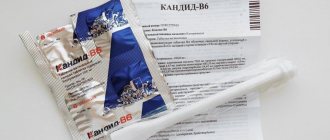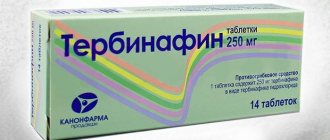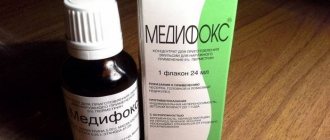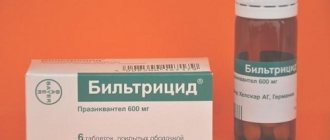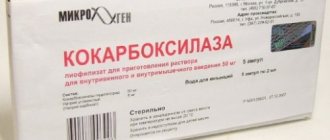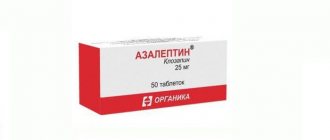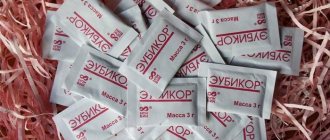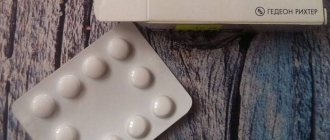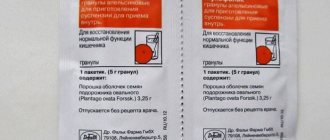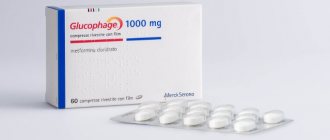Composition of Candide B
The cream contains two active ingredients - beclomethasone (250 mcg) and clotrimazole (10 mg). The product is packaged in aluminum tubes of 15 g and is a mass of homogeneous consistency, white in color. Contents of auxiliary components:
| Substance | Content, mg |
| Vaseline white | 120 |
| Purified water | up to 1000 |
| Propylene glycol | 50 |
| Liquid paraffin | 60 |
| Sodium Dihydrogen Phosphate Dihydrate | 0,8 |
| Sodium hydrogen phosphate | 0,6 |
| Emulsion wax | 135 |
| Methylparaben | 1,5 |
| Propylparaben | 0,5 |
| Sodium dipropionate | 0,4 |
Description of the drug
Candide B is a thick white cream with a weak specific odor of petroleum jelly. After application to the skin, the active components of the drug begin to be slowly absorbed into pathological lesions. They accumulate in the affected tissues and only then exhibit therapeutic activity. The cream is characterized by a long, prolonged antimycotic effect. What does Candide B help with:
- skin infection by pathogenic fungi, accompanied by severe inflammation;
- development of local allergic reactions complicated by secondary fungal infection.
With the help of the cream, acute pathologies characterized by severe symptoms are quickly relieved. The drug has also proven itself well in the treatment of chronic skin diseases, regardless of their stage of progression.
Candide B is used not only in dermatological practice, but also in allergology and traumatology. It always becomes the drug of first choice in the treatment of dermatitis and skin lesions complicated by infection. The external agent is intended for both pathogenetic and symptomatic treatment.
Pharmacological group and action
Candide B is included in the clinical and pharmacological group of combined drugs for the treatment of mycotic skin lesions. The drug has a powerful local antifungal, anti-inflammatory, antipruritic, analgesic and decongestant effect. Its therapeutic properties are due to the therapeutic activity of the main components:
- clotrimazole (imidazole derivative) is an antimycotic that interferes with the biosynthesis of ergosterols. The absence of this building material of fungal membranes leads to the dissolution of cells of infectious agents. Clotrimazole helps to increase the concentration of hydrogen peroxide in damaged tissues, accelerating the death of fungi;
- Beclomethasone (glucocorticosteroid) is a hormonal agent that inhibits the enzyme cyclooxygenase. Stops the processes of biosynthesis of prostaglandins from arachidonic acids, prevents the migration of macrophages to inflammatory foci. Beclomethasone eliminates a pronounced symptom of an allergic reaction - severe skin itching.
Due to the simultaneous suppression of the inflammatory process and the destruction of fungi in the tissues, blood circulation is accelerated. Cells begin to receive sufficient oxygen and nutrients for their restoration. Skin regeneration occurs much faster, so no marks remain on it.
Release form and composition
An Indian manufacturer produces Candide B in a 15.0 g package. The cream is placed in sealed aluminum tubes with a screw cap equipped with a protrusion. The secondary packaging of the drug is a cardboard box with attached instructions for use. The active composition is represented by clotrimazole and beclomethasone. The thick cream base is formed from the following components:
- propylene glycol;
- benzyl alcohol;
- butylated hydroxytoluene;
- emulsion wax;
- methyl parahydroxybenzoate;
- sodium phosphate;
- propyl parahydroxybenzoate;
- sodium dihydrogen phosphate;
- paraffin oil;
- Vaseline;
- purified water.
Many additional components have weak antiseptic properties. And Vaseline, wax and paraffin form a film on the surface of the skin. It allows oxygen to pass through well and retains moisture. But pathogenic microorganisms are not able to penetrate the protective film. This becomes an excellent prevention of secondary not only fungal, but also bacterial infection.
Pharmacological properties
The drug is a cream with an antimycotic anti-inflammatory effect, has an antiexudative, antipruritic and antiallergic therapeutic effect. Clotrimazole has a broad spectrum antifungal effect, is active against molds, yeasts, dermatophytes, microorganisms such as Trichomona vaginali, Pityriasis versicolor, fungi of the genus Candida albicans.
The second active component, beclomethasone, has an anti-inflammatory and antipruritic effect. By suppressing allergic and inflammatory reactions, this substance helps reduce the severity of symptoms of skin diseases. The systemic effect of the drug components when used externally is low. The maximum concentration of clotrimazole is observed in the epidermis, and not in the subcutaneous tissue or dermis.
Contraindications
The drug is not prescribed to allergy sufferers. The overall effect of clotrimazole on the skin is very insignificant, so there are few contraindications to its use. In reviews, some patients treated herpes simplex with Candida. This cannot be done. In case of hypersensitivity to certain components, the cream is not prescribed. Absolute contraindications for use:
- skin tumors;
- breastfeeding period;
- skin manifestations of syphilis;
- trophic ulcers resulting from chronic venous insufficiency;
- problems with liver metabolism;
- post-vaccination skin reactions.
Side effect
According to the instructions, negative effects when using Candide B are mild and appear with increased sensitivity to the components. If an individual allergic reaction occurs, redness of the skin, a burning or tingling sensation are recorded. The following side effects are extremely rare:
- acne-like changes;
- hypertrichosis;
- hypopigmentation;
- striae;
- skin atrophy.
In childhood
According to the instructions, patients under 16 years of age should be prescribed Candide by a doctor. If burning, itching or other skin reactions occur, wash off the cream. It is strictly forbidden to apply cream and additionally use occlusive dressings. This will lead to the penetration of beclomethasone into the blood and inhibition of the function of the adrenal cortex in children.
Analogues of Candide B
A doctor may prescribe an analogue of Candide B if treatment is insufficiently effective or if you have an individual allergic reaction to beclomethasone. The following drugs are produced, synonyms for the main active ingredient (clotrimazole):
- Imidil is a cream for external and intravaginal use. Prescribed for the treatment of fungal infections of the skin or mucous membranes.
- Amyclone is an antimycotic drug, available in the form of cream, powder, and vaginal tablets. It is used in the treatment of versicolor, urethritis, vaginitis, mycoses and epidermophytosis.
- Antifungol - the components of the cream have a fungicidal effect on fungal cells; in small doses it has a fungistatic effect.
- Canesten - the main active ingredients are active against most fungi and gram-positive bacteria (streptococci, staphylococci).
- Kandizol - cream is intended for external and intravaginal use, the action is aimed at inhibiting the proliferation of gram-positive microorganisms, yeast and mold fungi, dermatophytes.
- Clotrimazole is an antimycotic drug based on an imidazole derivative, in the form of cream, gel, vaginal suppositories and tablets. It is used during the treatment of dermatophytosis, trichophytosis, onychomycosis, candidiasis, microsporia.
special instructions
Primary and secondary infections caused by gram-negative bacteria are maintained in warm, moist conditions, including occlusive dressings. Therefore, the affected area is cleaned with soap before applying the cream. The drug should not come into contact with the eyes and mucous membranes. This may lead to an allergic reaction. When treating Candida, patients should follow the following instructions:
- If infection develops or spreads, discontinue the cream and begin antimicrobial therapy.
- Apply the product to a small area of skin and do not use occlusive dressings. Violation of this rule may provoke systemic absorption of beclomethasone.
- The duration of therapy should not exceed 1 month, because Clotrimazole and beclomethasone suppress adrenal function.
Price Candide B
The cream for external use can be purchased at a pharmacy; a doctor's prescription is not required. Price range for the drug in Moscow pharmacies:
| Name of pharmacy chain | Price, rubles |
| Planet Health | 476 |
| Trika | 516 |
| Gorpharma | 480 |
| SamsonPharma | 489 |
Article on the topic: Eucalyptus tincture - instructions for use and composition, indications, side effects and price
During pregnancy
While pregnant, doctors try to avoid prescribing any medications containing clotrimazole and glucocorticoids. The cream can be used during pregnancy if the benefits to the mother outweigh the risks to the fetus. Candide is used for a maximum of 5-6 days and small areas of the skin are treated with it. It is unknown whether clotrimazole passes into breast milk, so the drug should not be used during breastfeeding.
- How to unlock an iPhone if you forgot your password
- What are fertile days for women? How to determine the period and window of fertility in the female calendar
- What is content on Tele2: how to connect subscriptions
Instructions for use
According to the instructions for use, Candide B ointment is intended for external use. It is included in therapeutic regimens only after a series of laboratory tests. Such diagnostic measures are necessary to identify the type of infectious agents and their sensitivity to drugs. If dermatitis is complicated by a bacterial infection, then the use of Candide B is not advisable.
A drug with a hormonal component should be used in doses recommended by a doctor. After eliminating the symptoms, the amount of the drug should be reduced gradually. Otherwise, there is a possibility of “withdrawal syndrome”, which is characteristic of almost all glucocorticosteroids.
This is the name of the body’s reaction that occurs when the use of the drug is abruptly stopped. A person’s health worsens, and the symptoms of skin pathology return and become more intense.
Indications and contraindications
The drug is prescribed for the treatment of pathologies caused by microorganisms sensitive to clotrimazole. Candide B ointment treats only fungal infections complicated by acute inflammation of the skin. These include:
- athlete's foot - a fungal infection caused by infection with the fungus Trichophyton mentagrophytes;
- inguinal epidermophytosis - a lesion of the epidermis of fungal origin that occurs in large folds of the skin;
- cutaneous candidiasis - superficial skin lesions caused by fungi of the genus Candida;
- skin microsporia is a mycotic disease caused by keratinophilic mold fungi.
Candide B is not included in treatment regimens if individual intolerance to its ingredients is detected. The drug is not intended to eliminate the external clinical manifestations of syphilis, chickenpox, tuberculosis, blastomycosis, measles, and herpes. It is forbidden to use the cream during breastfeeding. The product is not used for the treatment of trophic ulcers, in the presence of benign and malignant neoplasms on the skin.
Pregnancy is a relative contraindication. Candide B can be prescribed to a woman if safer antifungal and anti-inflammatory drugs are ineffective.
Directions for use and doses
Before applying Candide B, wash the affected areas with soap and water and dry well.
In some cases, pre-treatment with antiseptic solutions is required. The cream is evenly distributed in a thin layer on the skin and lightly rubbed in with massaging movements up to 3 times a day. Single and daily dosages are determined by the attending physician. It takes into account the area of the lesion, the type of pathology, its stage, and the characteristics of the course of the inflammatory process. The duration of the therapeutic course is 10-14 days. For athlete's foot, longer use is required - 3-4 weeks. If after several days of treatment the intensity of symptoms does not decrease, you need to inform your dermatologist about this. The doctor will adjust the dosage regimen or prescribe a drug with a different active ingredient.
Side effects and special instructions
The instructions for Candide B provide a detailed description of the side effects of the cream. It is possible to develop a local allergic reaction, especially if the dosage regimen is violated. Clinically, it is manifested by a rash, itching, swelling and redness of the skin, and painful sensations.
There have been cases of skin atrophy, the formation of acne and stretch marks, excess hair growth, and lightening of the epidermis. If any adverse reaction occurs, Candide B must be discontinued. You need to wash it off the skin, take any antihistamine and consult a doctor for medical help.
Avoid contact of the cream with the eyes, mucous membranes of the mouth and nose due to the high risk of developing allergies.
When is Candide B6 prescribed to pregnant women?
Vaginal tablets Candide B6 during pregnancy are most often prescribed for the treatment of thrush, which often develops against the background of a weakened immune system. This drug may also be recommended for pregnant women for genital infectious diseases caused by fungi of the genus Candida or Trichonoma vaginalis. Such diseases include trichomoniasis and vulvovaginal candidiasis.
Candide can also be used for vaginal infections caused by bacteria susceptible to clotrimazole. If candidiasis was discovered in the later stages, then with the help of these suppositories, doctors sanitize the birth canal immediately before delivery in order to prevent the development of thrush in the child.
Release forms
The main form of release of “Candida” is a solution in which the concentration of the active substance is 1%. The product is sold in a 15 ml polyethylene bottle. The kit includes a dropper plug, which greatly simplifies the process of treating affected areas of the mucosa. The slightly viscous substance is colorless and odorless, but after using it, patients note a slight bitter taste in the mouth. The drug is also available in other form factors: ointment, spray, suspension, gel, powder and lotion. However, not all of the listed forms are intended for treating the oral mucosa.
In dentistry, the drug is used in the form of a solution.
